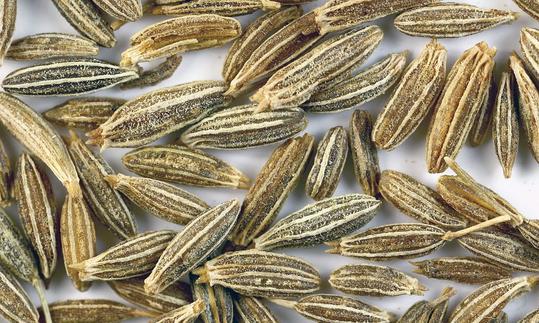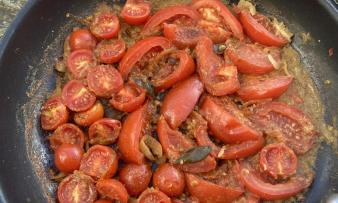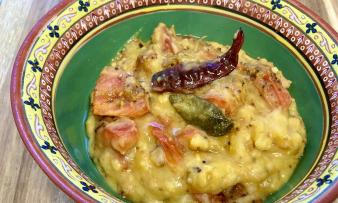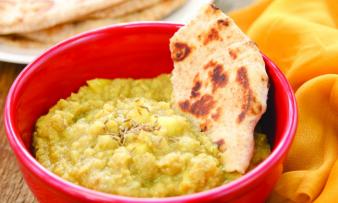Table of contents
The seeds of cumin ( Cuminum cyminum) have a full, slightly spicy taste.
Using cumin in cooking:
Raw cumin seeds have an intense, distinctive flavor. They are slightly hot, spicy and give dishes a "full flavor." Cumin differs from caraway seeds ( Carum carvi), which have a milder taste.
To intensify the flavor of cumin, you can roast the seeds briefly at medium heat and turn them frequently. As soon as they smell intense, stop roasting immediately, otherwise the aroma will evaporate and the seeds could burn. Ground cumin is not suitable for roasting as it burns too quickly.
What do you season with cumin? Cumin plays an important role in North African, Turkish and Greek cuisine, as well as in the cuisine of the Middle East, Iran and India, as well as Mexico and Brazil. Cumin is a component of many spice mixtures.
What dishes does cumin go with? Cumin is used to season spicy dishes, in soups, sauces and salads; or it can be added to stews, vegetable dishes and raw foods. Cumin goes well with an apple and lentil dal or Indian drumstick curry.
Vegan recipe for cumin rice (jeera rice):
Ingredients: 1 teaspoon canola oil, 2 teaspoons cumin seeds, 1 bay leaf, 1 half cinnamon stick, 4 cloves, 4 cardamom, 1.5 cups basmati rice, 3 cups water.
Preparation: Lightly roast the rapeseed oil, cumin and other spices in a pot over a low to medium heat until the spices give off an intense aroma. Add the rinsed basmati rice to the pot with the spices. Fry briefly for 2-3 minutes, stirring gently to prevent the rice grains from breaking. Add three cups of water to the pot and cook the basmati rice until there is almost no water left and the rice is al dente. Turn off the hotplate, cover the pot and leave covered for at least 15 minutes so that the remaining water can be absorbed.
Tea preparation/recipe for fresh cumin tea:
For fresh cumin tea, briefly crush 1-2 teaspoons of raw cumin seeds (dried) with a mortar so that the oil contained in the seeds can escape. Put the seeds in a cup and pour boiling water over them. Cover and let the tea steep for about 10 minutes. You can refine the cumin tea with freshly grated ginger, lemon juice and agave syrup.
Vegan recipes with cumin can be found under the note: " Recipes that have the most of this ingredient ".
| Not only vegans or vegetarians should read this: Vegans often eat unhealthily. Avoidable nutritional errors. |
Shopping - where to buy cumin?
Cumin can be found in major retailers such as Coop, Migros and sometimes in larger branches of Denner, Volg, Spar, Aldi, Lidl, Rewe, Edeka, Hofer all year round, sometimes also in organic quality (organic). You can also find cumin (raw) in organic shops, organic supermarkets (e.g. Alnatura or Denn's Biomarkt), health food stores and online.
You should prefer small quantities and use them quickly, as the aroma evaporates quickly. The harvest time for cumin seeds varies depending on the growing area (see Cultivation - Harvest). 1 Cumin is available in stores all year round.
Found in the wild:
Cumin can also be found growing wild in the growing areas (growing areas are listed under the origin and occurrence of cumin).
Storing cumin seeds:
Cumin is best stored dry and in an airtight container.
Ingredients of cumin - nutritional value - calories:
Here we show you the realistic ingredients of spices and herbs per 1 g (instead of per 100 g as usual - except for the amino acids).
Cumin seeds contain 3.75 kcal/1g. The fiber content is well measured at 0.1 g/1g. Proteins are also well represented at 0.18 g/1g. 2
The high iron content is striking. 1g of cumin contains 0.06g of iron, which corresponds to around 4.74% of the daily requirement. Marjoram (0.08g/1g) and basil (0.09g/1g) have similar values. Thyme covers around 8.8% of the daily iron requirement with 0.14g/1g. 2
The manganese, calcium and magnesium content is negligible in normal consumption quantities. Manganese is contained at 3.3 mg/100g. If consumed at 1g, this would cover 1.67% of the daily manganese requirement. 2 The calcium content at 931 mg/100g is similar to that of allspice (661 mg/100g), while poppy seeds contain 1438 mg/100g. 1g of cumin only covers 1.16% of the daily calcium requirement. Magnesium is contained at 366 mg/100g. 1g of cumin only covers 0.98% of the daily requirement. 2
The ratio of LA : ALA is 18:1 and is comparable to that of caraway seeds and pecans (21:1). 2 Since the Federal Nutrition Commission recommends a ratio of <5:1, caraway seeds do not have optimal values, but are not in the extremely deficient range either.
The complete ingredients of cumin, which cover the daily requirement and comparison values with other ingredients can be found in our nutrient tables below the ingredient image.
Dangers - Intolerances - Side effects:
Can you eat too much cumin? Cumin has many positive health properties and gives food an interesting taste. However, you should not consume larger amounts than those indicated in the recipes.
Cumin has been partially discredited because it contains high levels of pyrrolizidine alkaloids (PA). 3 Pyrrolizidine alkaloids are natural plant ingredients. However, high levels of them lead to liver damage and are suspected of causing cancer. Humans absorb PA mainly through honey, spices, herbs, tea, herbal tea and food supplements. In many cases, these are contaminations from wild plants containing PA that end up in plant-based foods that are actually PA-free during harvesting or in the manufacturing process. From July 2022, maximum levels will come into force in the EU to reduce exposure to PA. 4
In traditional folk medicine, cumin is sometimes used as an abortifacient or to induce labor. 13,14 This is why some people warn against eating cumin during pregnancy. Studies on mice showed that cumin, like other spices (including fenugreek), caused contraction of the uterine tissue. 6 However, there is no scientific information on the safety or danger of cumin or cumin tea during pregnancy or breastfeeding. 5
Health aspects - effects:
Cumin contains a lot of iron. One teaspoon of cumin (approx. 2 g) contains 0.12 g of iron, which covers around 9.48% of the daily requirement. 2 Iron deficiency is a widespread phenomenon, especially among children and young women. Occasional consumption of cumin can help to improve iron supply. 7
Seasoning food with cumin seeds can help prevent food poisoning, as they have antifungal and antibacterial effects. This could be one reason why this spice is used in many dishes in certain countries. In vitro it has been proven several times that cumin inhibits the growth of certain molds (Aspergillus). These molds are particularly dangerous for people with poor health or immune deficiencies and can cause pneumonia, among other things. 10,11 Cumin also has an antibacterial effect and is effective against otherwise multi-resistant staphylococci (Staphylococcus aureus). The concentration of cumin used was so low that the staphylococci did not develop any microbial resistance after treatment. 12
There is controversy over whether cumin promotes weight loss. 8,9 You can find out more about this under the ingredient ground cumin.
Folk medicine - natural medicine:
In folk medicine, cumin is used to treat hoarseness and diarrhea, among other things. The seeds are said to be diuretic and soothing for the stomach. In America, Africa and India, cumin was used as an abortifacient and as an emmenagogue (a remedy to support menstruation). 13,14
Occurrence - Origin of cumin:
Where does cumin come from? Cumin ( Cuminum cyminum L.) is a member of the Apiaceae family, which originated in the Mediterranean region, Egypt and Central Asia. Cumin spread throughout the Middle East, China and India. It is one of the oldest and most economically important plant species. Cumin is drought tolerant and is mainly grown in Mediterranean climates. 13
In international trade, no distinction is made between cumin, black cumin and bitter cumin / kalijiri ( Centratherum anthelminticum L. Kuntze). The latter is consumed mainly in India. Therefore, there is no precise data on the global production of cumin. It is estimated that the total world production is between 580 and 600 thousand tons. The main producer in 2020 is India (86% market share), followed by Iran (4%), Syria (3%) and Turkey (2%). The remaining 5% comes from various countries such as Afghanistan, Egypt, Pakistan and Afghanistan. India consumes around half of its own production of cumin. 1
Growing in the garden or as a potted plant:
Cumin needs a sunny spot that is as warm as possible. Cumin needs temperatures of 18° to 20° Celsius to germinate and around four sunny months to ripen. Sowing directly in the bed is therefore only possible in very warm areas. In cooler areas, it is therefore worth growing cumin indoors. Since cumin is very sensitive to frost, it should only be planted in the bed when there is no longer any risk of frost. As soon as the cumin has grown to around ten centimeters, you can easily reduce watering to once a week. As an adult, cumin prefers moderately dry soil. 15
Cultivation - Harvest:
Cumin needs four months in the sun before it is ready to be harvested. As soon as the cumin herb slowly turns a brownish color, you can start harvesting. To do this, cut the fruit clusters as long as possible, bundle them and hang them up to dry. Alternatively, you can spread the fruit clusters out on a grid or net and dry them in the sun. As soon as the fruit clusters are dry, you can rub out the seeds. 15
The harvesting period of cumin seeds varies from country to country, but in the main production regions it starts in India in February/March, then in Syria (April), Iran (May) and finally in Turkey (August). Post-harvest operations include threshing, drying, cleaning, sorting, heat treatment (often carried out to avoid microbiological risks), grading and packaging. 1
Risk of confusion and possibilities:
In addition to cumin, there are other spices that are called caraway: for example, black cumin ( Nigella sativa) and caraway ( Carum carvi). However, these are different plants. Black cumin belongs to the buttercup family. Cumin and caraway are umbelliferous plants.
General information:
Cumin ( Cuminum cyminum) is an annual umbelliferous plant that grows to a height of 50 cm and has finely divided leaves. The flowers are white or pink. The taste of cumin comes from the essential oil cuminaldehyde.
Alternative names:
Cumin is also known as cumin or cumin. Other names are mother cumin, Roman cumin, white cumin or Welsch cumin.
Keywords for use:
A study shows that cumin extracts affect melanin production, which is why it is suggested that it should be investigated further as a potential skin lightening agent in the cosmetics industry. 16
Cumin essential oil has been shown to be more effective than commercial insecticides and has been proposed for the development of innovative, organic crop protection products. 17
Literature - Sources:
Bibliography - 17 Sources
| 1. | Centre for the Promotion of Imports. The Netherlands Ministry of Foreign Affairs. The European market potential for cumin seeds. 2021. |
| 2. | USDA United States Department of Agriculture. |
| 3. | bfr.de Bundesinstitut für Risikobewertung. Aktualisierte Risikobewertung zu Gehalten an 1,2-ungesättigten Pyrrolizidinal-kaloiden (PA) in Lebensmitteln. 2020. |
| 4. | Bundesamt für Lebensmittelsicherheit und Veterinärwesen. Pyrrolizidinalkaloide. 2021. |
| 5. | Ahmed M, Hwang JH, Choi S, Han D. Safety classification of herbal medicines used among pregnant women in Asian countries: a systematic review. BMC Complement Altern Med. Nov 2017;17(1): 489. |
| 6. | Ashwani Chumber and Teresa Degolier. The influence of common cuisine spices such as ajwain, cumin, dill, fenugreek, and papaya on the contractile behaviors of isolated strips of mouse uterine tissue. J Pharmacogn Phytochem 2020;9(2):1145-1150. |
| 7. | Leitzmann C, Keller M. Vegetarische Ernährung. 3. Auflage. Verlag Eugen Ulmer KG: Stuttgart. 2013. |
| 8. | Taghizadeh M, Memarzadeh MR, Abedi F, Sharifi N, Karamali F, Fakhrieh Kashan Z, Asemi Z. The Effect of Cumin cyminum L. Plus Lime Administration on Weight Loss and Metabolic Status in Overweight Subjects: A Randomized Double-Blind Placebo-Controlled Clinical Trial. Iran Red Crescent Med J. 2016 May 23;18(8): e34212. |
| 9. | Zare R, Heshmati F, Fallahzadeh H, Nadjarzadeh A. Effect of cumin powder on body composition and lipid profile in overweight and obese women. Complement Ther Clin Pract. Nov 2014 ;20(4): 297-301. |
| 10. | Khosravi AR, Minooeianhaghighi MH, Shokri H, Emami SA, S M A, Asili J. The potential inhibitory effect of cuminum cyminum, ziziphora clinopodioides and nigella sativa essential oils on the "growing" of Aspergillus fumigatus and Aspergillus. Braz J Microbiol. Jan 2011;42(1): 216-24. |
| 11. | Mohammadpour H, Moghimipour E, Rasooli I, Fakoor MH, Alipoor Astaneh S, Shehni Moosaie S, Jalili Z. Chemical Composition and Antifungal Activity of Cuminum cyminum L. Essential Oil From Alborz Mountain Against Aspergillus species. Jundishapur J Nat Pharm Prod. 2012;7(2): 50-5. |
| 12. | Sharifi A, Mohammadzadeh A, Salehi TZ, Mahmoodi P, Nourian A. Cuminum cyminum L. Essential Oil: A Promising Antibacterial and Antivirulence Agent Against Multidrug-Resistant Staphylococcus aureus. Front Microbiol. 2021 Aug 4;12: 667833. |
| 13. | Mnif S, Aifa S. Cumin (Cuminum cyminum L.) from traditional uses to potential biomedical applications. Chem Biodivers. May 2015;12(5): 733-42. |
| 14. | Al-Snafi A E, The pharmacological activities of Cuminum cyminum – a review. Journal of Pharmacy, June 2016;6(6): 46-65. |
| 15. | Gartendialog.de Kümmel, Kreuzkümmel - Anbau, Pflege und Ernte. |
| 16. | Wang Y, Du GY, Guo T, Zou HM, Jia D. Skin-whitening mechanism of cumin (Cuminum cyminum L.) extract. Pak J Pharm Sci. Jan 2021;34(1): 77-84. |
| 17. | Benelli G, Pavela R, Petrelli R, Cappellacci L, Canale A, Senthil-Nathan S, Maggi F. Not just popular spices! Essential oils from Cuminum cyminum and Pimpinella anisum are toxic to insect pests and vectors without affecting non-target invertebrates. Ind. Crop. Prod. 2018;124: 236–243. |











Comments